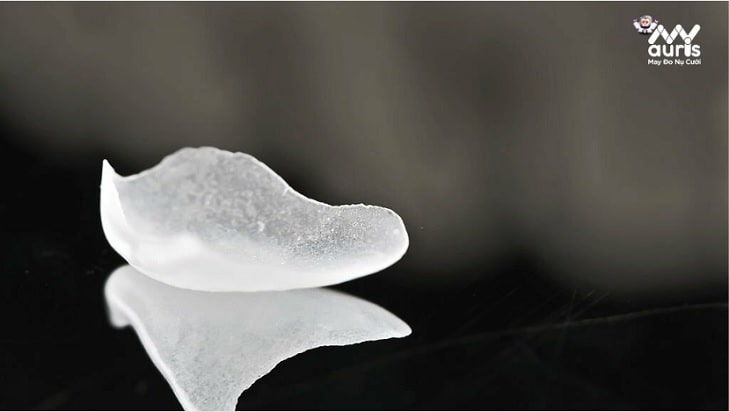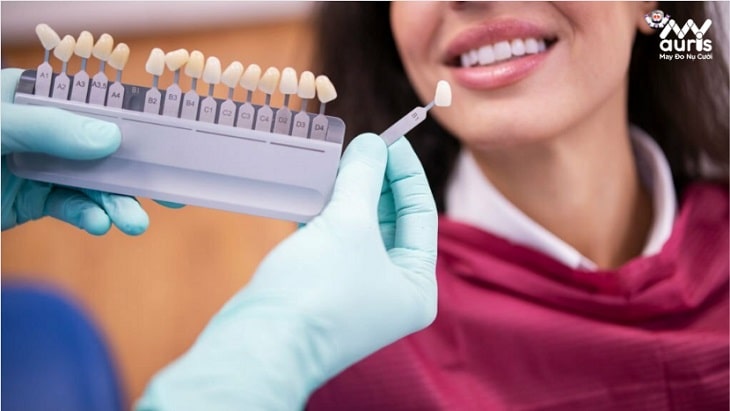Many people choose cosmetic dentistry methods such as porcelain crowns or porcelain crowns. Among them, porcelain veneers are one of the cosmetic methods that do not grind the tooth pulp or grind very little, so it does not invade the real tooth structure. So what are porcelain veneers? What are the advantages? Let’s find out in detail through the article below!
What is porcelain veneer?
Veneers are usually made from ceramic, composite, or synthetic plastic, etc. Porcelain is most commonly used to increase aesthetics for the user. Veneers are designed as thin porcelain veneers with a thickness of 0.3 – 0.5 mm, similar in color to the tooth color, attached directly to the outer surface of the tooth, and fit tightly to the tooth crown. Thanks to that, the tooth shape is improved and the desired aesthetic is achieved.

The Veneer tooth bonding method is applied to some cases of aesthetic treatment. Typically, in specific cases, porcelain dental veneers can be applied such as:
- Clients with teeth with worn edges;
- People with cracked or chipped teeth due to trauma;
- People with gapped teeth, with gaps between teeth;
- People with mild tooth misalignment, uneven development or abnormal shape;
- People whose teeth are stained due to smoking or using antibiotics and have applied tooth whitening methods but are ineffective;
When performing Veneer, the doctor will grind a thin layer on the tooth surface, or even not grind (if the tooth crown is done). meet the conditions). Thanks to modern porcelain dental bonding techniques, it will not affect dentin or tooth tissues. Furthermore, during the procedure, the patient will be anesthetized, thereby reducing the feeling of pain during the procedure.
Distinguish between porcelain veneers and porcelain crowns
Regarding cosmetic methods for teeth, porcelain crowns are well known. Furthermore, with this technique, the doctor will grind away a part of the real tooth tissue and then place a porcelain crown on top. In many cases of severe tooth decay, the doctor will perform a root canal to protect the toothreal and then coated with porcelain.

However, compared to porcelain veneers, porcelain veneers are a less invasive treatment technique, thus capable of preserving the maximum amount of real teeth while still ensuring high aesthetics. Specifically:
Instances of application
Porcelain Veneer and porcelain veneers are performed in the following cases:
- Porcelain Veneers: Usually applied in cases where teeth are dark, yellow, worn or broken to a moderate degree. For broken or worn teeth, no more than ⅓ of the tooth crown is worn.
- Porcelain crowns: Often used to restore severely damaged teeth such as extremely bad tooth color, uneven teeth or broken teeth. Or cases of severe tooth decay or total loss of teeth as well as teeth with slight bite misalignments such as protruding teeth, underbites, etc.
Performance technique
About the porcelain veneer technique, The doctor will grind a thin layer on the outer surface of the tooth crown with a grinding rate of about 0.3 – 0.5mm. Furthermore, the enamel layer or tissues around the teeth will not be affected.
In contrast, with porcelain crown, the doctor will grind the real tooth base with a grinding rate of no more than 2mm, then proceed to attach a porcelain crown on top. This process can affect the tooth pulp or even require a root canal if the tooth is severely damaged.
Durability of use
Depends on the type of porcelain you choose and how you take care of your teeth If you have a good mouth, porcelain veneers can last 10 – 15 years. And the lifespan of ceramic coating can be up to 20 years. However, to ensure durability, you need to take good care of your teeth and at the same time give up bad habits such as smoking, being lazy to brush your teeth, or eating hard foods, etc.
Advantages of porcelain veneers
Currently, porcelain veneers are an aesthetic solution for teeth chosen by many customers and favored by specialists, for the following reasons:
- High aesthetics: Porcelain tooth bonding method will change the color, shape and size of the teeth. From there, helping your teeth become more even and beautiful, the natural porcelain veneer color will help you look fresher and more confident when you smile.
- Less impact on real teeth: When applying porcelain veneers, you only need to grind very little real tooth tissue, this will not cause damage to the teeth. At the same time, this method rarely causes pulp death or requires root canal treatment;
- Ensure chewing function: The doctor only grinds the tooth crown at a rate of 0.3 – 0.5mm, so it does not affect the structure of the tooth tissue too much. In particular, this method does not invade the tooth pulp, so it limits tooth sensitivity.
- High durability: Porcelain veneers are highly durable with an average lifespan of about 10 – 15 years if performed by a highly skilled doctor, modern equipment at a reputable clinic and proper oral care at home.

Process of performing porcelain veneers
My Auris Dental performs porcelain veneers according to medical standards and at the same time applies the procedure according to WTS standards with all the following steps:
Step 1 – Examination and X-ray: In this step, the doctor will evaluate the current tooth condition as well as the color and brush the teeth to have an appropriate treatment plan. Furthermore, the doctor will order an X-ray. In case the customer has had root canal treatment, veneers will not be prescribed but porcelain crowns will be used instead.
Step 2 – Porcelain Veneer design: With the collected data, the doctor will sketch a plan as well as choose the tooth color and design the tooth shape to suit each customer’s face.
Step 3 – Proceed to grind the tooth base and attach a temporary tooth: After you agree with the doctor’s treatment plan. The doctor will grind the teeth that need to be treated and attach temporary teeth to use to ensure aesthetics while waiting for the Veneer porcelain veneers.
Step 4 – Porcelain Veneer: When the Veneer teeth are completed, the doctor will use a special gel to adhere to the teeth, thereby bringing a smile to the teeth. brilliant.
Step 5 – Check and adjust the bite: Within 1 – 3 days after attaching porcelain teeth, you will need to return to the clinic for the doctor to check and adjust the bite if necessary. This is a very important step to help you avoid feeling scratchy when biting or communicating, especially to avoid porcelain breakage and prolong usage time.
DentalMy Auris department is a reputable dental unit that you can trust to fix dental conditions. Above is useful information about cosmetic methods as well as what porcelain veneers are. If you want to learn about the service, please contact My Auris dentistry directly, the doctors will advise you in more detail!
Kim Dung





